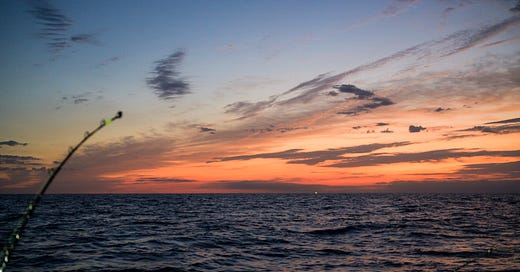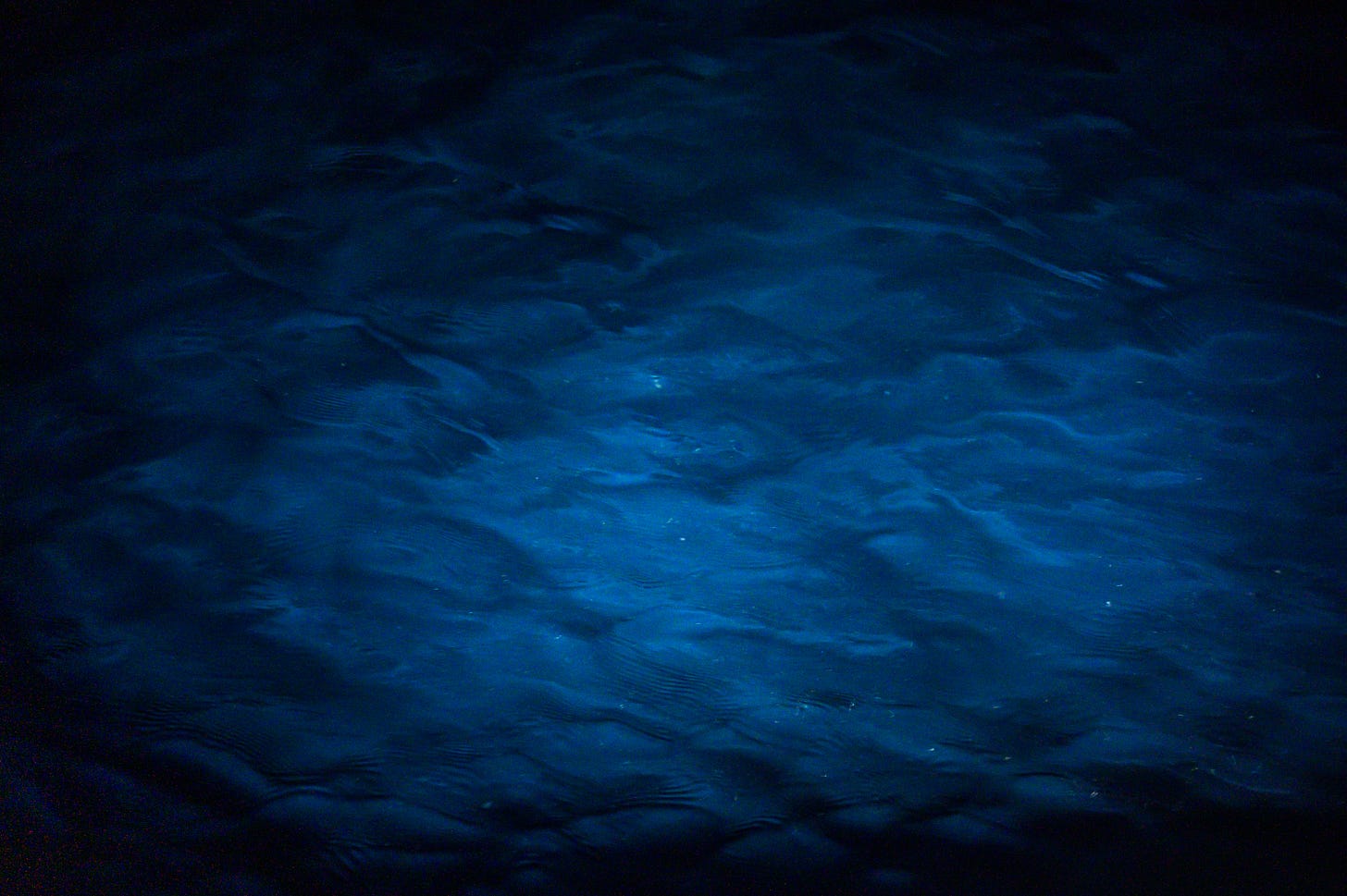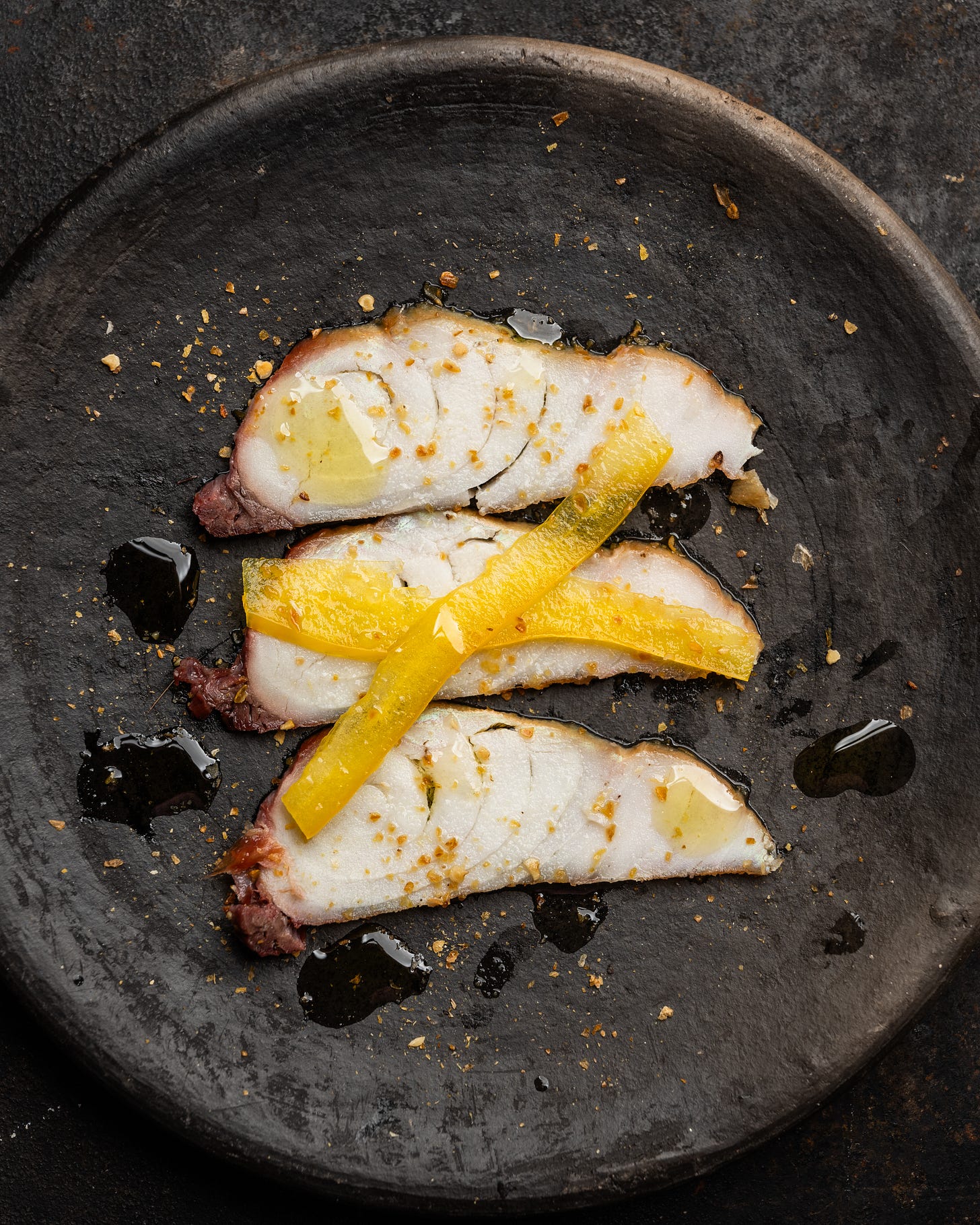Hi friends!
It’s windy and warm in New Orleans this week, with a faint hum in the air as Super Bowl activities fade away and parade preparations ramp back up. Mardi Gras season has felt a little longer this year, but we’re heading into the depths of it now, so time to start hot gluing those costumes together. What’s our inspiration this year? I’m glad you asked! It’s the crows, obviously.
Weekend before last, I was invited to join a small group heading offshore for a day of fishing. I’ve only been out in the Gulf of Mexico1 a few times, and have only been more than 10 miles offshore just once before, but this was a much longer haul, requiring an absurdly early wake-up time. I scribbled out a few thoughts throughout the day, and have pieced those together in an attempt to describe what a unique experience it was.
Logan’s text came late afternoon on Saturday. “Wanna make a crazy 100-mile run?” He was already in Grand Isle and had previously indicated that there may be room for me on Sunday’s outing. Of course I wanna, I thought, I just needed to figure out a few logistics. “K. We’re leaving at 3 a.m.,” he informed me, before calling to let me know there was a spot on the couch at the cabin if I wanted to drive down and crash there for a few hours, in lieu of a commute after midnight.
For those who haven’t been out in the gulf, there are a few things worth noting here. First, weather is critical—this time of year, if it’s too windy the water gets very rough, but fortunately the forecast looked calm. Second, any amount of distance feels significantly longer over water than over pavement, even on a large boat with enough power to move fast. Just imagine, if you will, a pothole-lined street that’s been partially ripped up for repairs, then covered in gravel (but without filling in any of the bigger holes). Now imagine driving across that at about 40 miles an hour in a car with no suspension. Okay, maybe that’s not what the whole ride feels like, but give it enough time and the water will rattle every bone and joint in your body.
I fell asleep on the couch at the cabin around 10:15 p.m. and jostled awake at 1:59 a.m., one minute before my alarm went off. We loaded the boat and headed out, passing under Grand Isle Bridge by 2:45 a.m. headed southwest. I was offered a bean bag chair, which softens the ride, and laid back listening to the hum of four brand-new, 350-horsepower outboard motors, hat pulled over my eyes as I tried my hardest to fall asleep. But I was too excited. The skies above us were clear, but light pollution from the shoreline and a cluster of oil rigs drowned out the stars. Eventually, those lights faded and the waters grew darker; they would have felt ominous if they weren’t so ripe with anticipation.
There’s this feeling that I get sometimes when I’m up early, driving through the dark to get to the woods or the water. It’s a wash of calm, followed by a deep sense of gratitude. I literally feel my shoulders ease and my eyes open wider as I think about just how lucky I am to do this, whatever this is—walking through the woods, seeing the sun rise over the marsh, breathing in fresh air. I’m not religious, but I felt it there, in the back of the boat, and for a brief moment, I just wished that someone or something out there could hear my appreciation. My shoulders relaxed and I sank deeper into the bean bag, finally drifting off to sleep.
I woke up around 5:30 a.m. as the boat slowed to a gentle stop, miles from any sort of structure. Our destination was a pin drop near a salt dome, located several hundred feet below—a known spot, evidently, for big fish. We were the first boat to arrive but soon would be joined by others as we trolled the open water. We didn’t find any wahoo (our desired catch) but we did pull in a large blackfin tuna and two king mackerels, one of those weighing 40+ pounds.
We spent the rest of the day bouncing around the gulf, exploring ridges and wreckage and rigs in search of other species, but mostly finding schools of sharks. This kind of fishing is much slower than inshore—bait has to drop hundreds of feet to reach fish on the bottom, and fishing holes are many miles apart—but it’s also much more communal, and the banter between everyone helps pass the time when you’re not catching.
If the morning trek felt long, the return ride seemed unending, watching as the water faded from dark blue to cobalt to aquamarine as sediment from the Mississippi River filtered in. We made it back to the cabin just before sundown and spent an hour unloading, washing the boat, and cleaning fish. I packed a couple of mackerel fillets in the ice chest alongside the collars from a yellowedge grouper and headed home, exhausted but ever more grateful.
A Citrusy Smoked Mackerel Dip
Mackerel, as I’ve now learned, are fun to catch but don’t rank very high on the list of the gulf’s sought-after species for eating. The meat is light grey in color, a little oily, and fairly dense, so it takes some finesse, but when cooked properly (and fresh!), I assure you it’s quite tasty. I first seared a piece gently in olive oil to get a sense of its characteristics, and would compare the flavor and texture to a thin cut of swordfish.
I decided to smoke two fillets, taking inspiration from a fishing forum for the brine, which is similar to what I use for redfish. I then chopped those smoked fillets and soaked them in lemon juice with bell pepper for a tangy, smoky fish dip that I could bring to a friend’s Super Bowl party. It went over well!
[Note: Offshore fishing is out of reach for many, but you can find mackerel and several great substitutes rotating through the case at Porgy’s!]
Ingredients
3/4 cup packed brown sugar
2 tbsp + 1/2 tsp sea salt, divided
3/4 cup distilled or filtered water (chlorine in tap can affect the flavor)
2 lbs king mackerel fillets
1 small yellow bell pepper, seeded and minced
2 lemons, juiced
1/2 tsp sugar
1/2 tsp hot paprika or other sweet + spicy chile2
1 tbsp olive oil
Instructions
Combine the brown sugar, 2 tbsp salt, and distilled water in a large resealable bag. Seal and shake to combine, then add the fillets and remove as much air as you can before re-sealing. Store in the fridge for at least 1 hour but no more than 2—too long in the brine and the fish will be very salty. Remove the fillets, pat dry with paper towels, place on a baking rack, and return to the fridge for at least another hour, until the fish has developed a thin film (known as a pellicule)—this will help keep the meat moist as it smokes.
Smoke at 175°F over hardwood for 45 minutes, then increase the heat to 225°F and cook just until the fish reaches an internal temp of 165°F. (You could smoke it longer for a firmer, almost jerky-like texture, but we want it to stay tender for the dip.)
Allow the smoked fish to cool, uncovered, to room temp. It can then be stored in the fridge until ready to use.
To make the dip, roughly chop the smoked mackerel fillets and add them to a bowl along with the bell pepper, lemon juice, remaining 1/2 tsp salt, and sugar. Let marinate for 10 minutes, taste to adjust salt or acidity, then sprinkle with the paprika and drizzle with olive oil. Serve with corn chips, saltines, or small toasts!
Lagniappe
A few things that caught my attention this week:
Despite large crowds last weekend, small businesses throughout the city report slow sales, even in the French Quarter.
Steve “the cake man” Himelfarb and restaurant critic/author Tom Fitzmorris both passed this week. Separately, a celebration of life for beloved photographer Pableaux Johnson will be held on Saturday, February 22.
Louisiana rice farmers may lose out on millions of dollars after recent cuts to USAID.
As egg prices continue to climb, local restaurants are forced to adjust menu prices, too.
Louisiana’s Wildlife Commission filed a notice of intent to expand alligator hunting season to December 31 for both the east and west zones.
Alisha Miranda wrote about Saint-Germain for Plate Magazine, highlighting a business model that remains debt-free.
Bronwen Wyatt shared a recipe for a prune, coffee, and almond galette des rois.(IYKYK)
Thanks for reading, y’all, thanks to Greg for taking us out in the gulf, and thanks to Logan for always bringing me in on these grand adventures. Give him a follow for more fish adventures (and cooking)!
When I was about 13 I asked my family to call me James, the name they wrote on my birth certificate. Most tried but gave up after a short time, and to this day, I’m still known to some as “Jamie.” For this and about fourteen other reasons, I will continue referring to the water south of us as the Gulf of Mexico.
Boonville Barn Collective is run by dear friends in Northern California, and I keep the pantry stocked with their dried chiles. I used aji limon for this recipe; it looks to be out of stock, but the sugar rush would be just as good (and maybe a little more forgiving).









